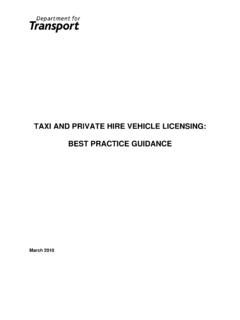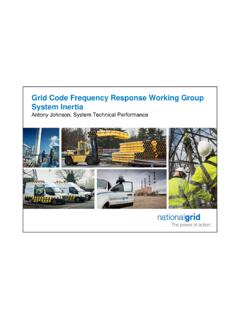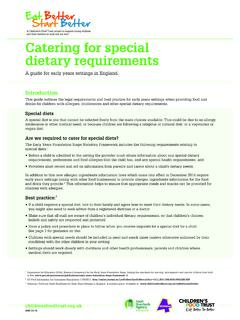Transcription of Assessment and the EYFS Reforms What does this look like ...
1 Assessment and the EYFS. Reforms What does this look like in practice? 28th June 2021. Penny Cartwright (on behalf of hackney Education Early Years). EYFS Consultant and Trainer Aims of session participants will have opportunities to: Consider the reasons for the changes to the Statutory framework for the EYFS, effective 1st September 2021. Develop understanding of the Assessment requirements and the principles of Assessment as set out in the revised EYFS. Reflect on the purpose of observations and Assessment and what effective assessments really mean in practice. Become familiar with the non-statutory guidance documents (Development Matters 2020 and Birth to Five Matters 2021) and consider how these can be used to support everyday practice.
2 Reflect on current Assessment systems and what is working well. Identify priorities to implement the new framework from the 1st of September. Rationale behind Reforms Word gap' - these gaps are particularly pronounced in early language and literacy. 1 in 4 children who struggle with language at the age of five do not reach the expected standard in English at the end of primary school. Children with vocabulary difficulties at age five are 3. times more likely to have mental health problems in adult hood and twice as likely to be unemployed. EYFS Profile results for 2019: children achieved at least the expected level for Communication and Language and Literacy. ( in 2013). Improvements made but we still need to do more to narrow the gap.
3 Rationale behind Reforms Two key objectives - improve outcomes for all children (particularly in language and literacy). reduce teacher/practitioner workload (more time interacting with children). Focus on strengthening language and vocabulary development (disadvantaged, word gap'). Strengthen literacy and numeracy outcomes in preparation for year 1. Early learning goals to be clearer, more specific, easier to make accurate judgements Early learning goals to reflect strongest predictors of future attainment What is changing and when? Revised Statutory framework for the EYFS. Final version published 31st March 2021. To be implemented by all schools, settings and childminders from 1st September 2021.
4 Key changes Learning and Development requirements Educational programmes for the seven areas of learning (the curriculum). Minor changes to Safeguarding and Welfare requirements Assessment requirements Assessment and the EYFS. Reforms What is changing? What does this mean for you and your everyday practice? Assessment and the EYFS Reforms Two key objectives - improve outcomes for all children - reduce teacher/practitioner workload Revised Assessment requirements end of reception Principles of Assessment (at end of reception and throughout EYFS). What does this mean in practice? Encourage teachers/practitioners to use their professional judgement and reduce reliance on unnecessary evidence and paperwork Focus on what's important to children what will make the most difference to children Reduce teacher/practitioner workload Why do you think this was one of the objectives?
5 What does the current EYFS say about excessive paperwork? Assessment Assessment should not entail prolonged breaks from interaction with children, nor require excessive paperwork. Paperwork should be limited to that which is absolutely necessary to promote children's successful learning and development.'. (EYFS Statutory Framework 2017 page 13). Learning journeys Background information, Planning interests, Celebration of achievements needs Monitoring Photos, Observations Children's development caption, (AOL, COEL). voice (DM. samples All adults statements). Parents Evidence Formative assessments Tracking & summative progress assessments - data Starting points, (individuals/ Next steps . transition + ?)
6 Cohort) 11. Bold Beginnings Ofsted (2017). A Reception teacher felt under constant pressure to provide evidence for children's learning. Photographs were taken constantly during day to-day activities to capture children's successes. This was said to stop the flow of teaching and take staff away from working directly with children. It also meant that more time was spent at the end of the day to print the photographs, stick them into individual children's folders and write a summative statement to explain each of the photos .. Bold Beginnings Ofsted (2017). One learning journey' included 15 photographs of a child putting on their coat, at various times across the year and with varying degrees of success.
7 Some staff thought this was necessary to provide evidence of progress. When the teacher was asked whether they knew themselves, without 15 photographs, whether the child had accomplished this aspect of self-care and independence, they said yes' immediately.'. Reflect/Discuss your Assessment systems What do you currently do? Does your planning/ Assessment mean practitioners have prolonged breaks' from interaction with children? Do you think your paperwork is excessive'? Who is the paperwork for? Is paperwork limited to that which is absolutely necessary to promote children's successful learning and development? What works well? What are the challenges? What could be improved? PLEASE SHARE USING CHAT.
8 Assessment and the EYFS Reforms Assessment requirements Progress check at age two Changes to the Assessment at the end of reception (Schools - June 2022). EYFS Profile (17 new Early Learning Goals). Clearer, more specific, easier to make accurate judgements Emerging/Expected No longer Exceeding judgement Aspect/Early Learning Goals Early Learning Goals Current Reforms Communication and Language Listening and Attention Listening, Attention and Understanding Understanding Speaking Speaking Personal, Social and Emotional Development Making Relationships Self-Regulation Self-Confidence and Self- Managing Self Awareness Building Relationships Managing Feelings and Behaviour Physical Development Moving and Handling Gross Motor Skills Health and Self-Care Fine Motor Skills Aspect/Early Learning Goals Early Learning Goals Current Reforms Literacy Reading Comprehension Writing Word Reading Writing Mathematics Numbers Number Shape, space and measures Numerical Patterns Understanding the World People and Communities Past and Present The World People.
9 Culture and Communities Technology The Natural World Expressive Arts and Design Exploring and Using Media Creating with Materials Being Imaginative Being Imaginative and Expressive Making assessments against the Early Learning Goals When forming a judgement about whether an individual child is at the expected level of development, teachers should draw on their knowledge of the child and their own expert professional judgement. This is sufficient evidence to assess a child's individual level of development in relation to each of the ELGs. Sources of written or photographic evidence are not required, and teachers are not required to record evidence.'. (Statutory framework for the EYFS. 1st September 2021, page 11).
10 Assessment and the EYFS Reforms (throughout the EYFS). Assessment should not entail prolonged breaks from interaction with children, nor require excessive paperwork. When assessing whether an individual child is at the expected level of development, practitioners should draw on their knowledge of the child and their own expert professional judgement and should not be required to prove this through collection of physical evidence.'. (Statutory framework for the EYFS. 1st September 2021 page 18). The purpose of observations and assessments To find out about individual children, their development, needs and interests To inform plans to support individual children, their learning and development, needs and interests To monitor children's development in all areas of learning Share information with parents/other professionals To evaluate effectiveness of our provision To meet the requirements of the Statutory framework for the EYFS.



